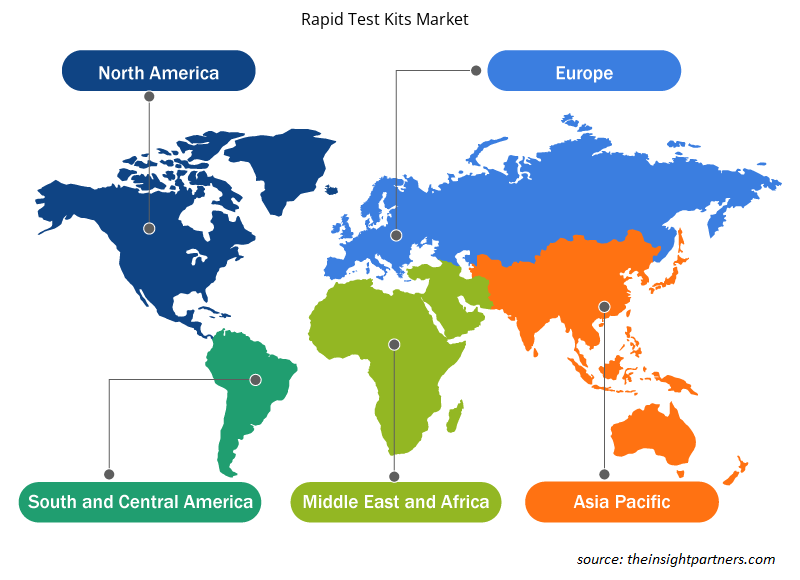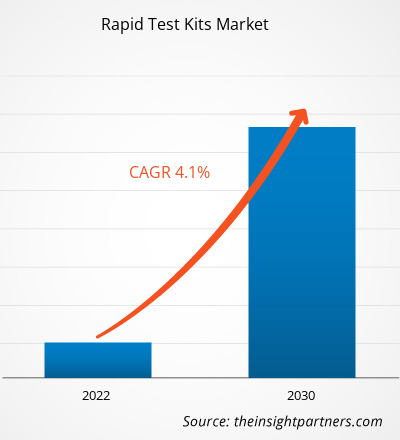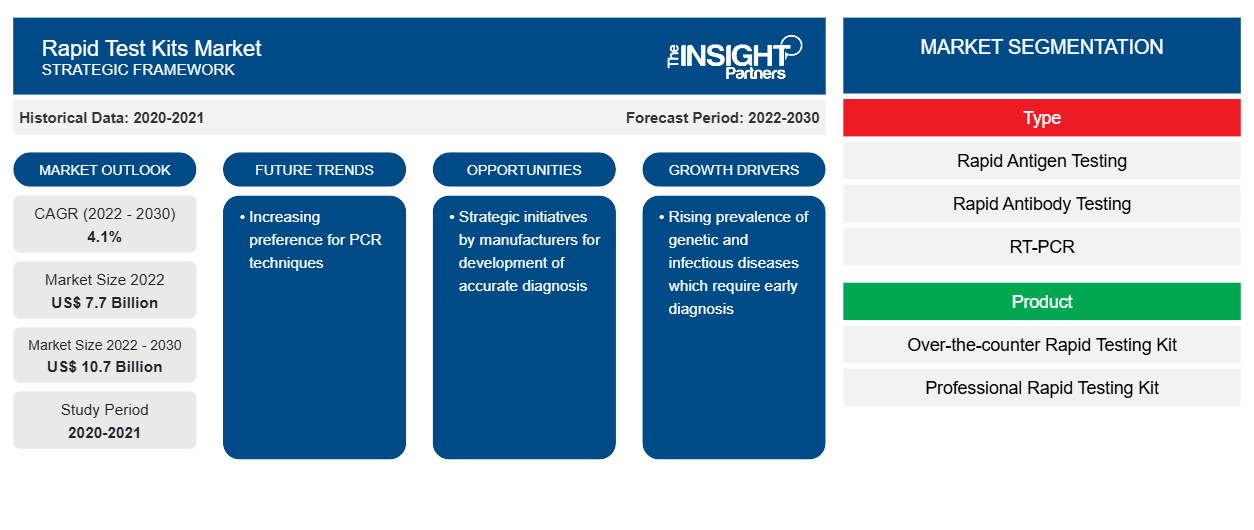Si prevede che le dimensioni del mercato dei kit per test rapidi cresceranno da 7,7 miliardi di dollari nel 2022 a 10,7 miliardi di dollari entro il 2030; si stima che registrerà un CAGR del 4,1% nel periodo 2022-2030. È probabile che l'innovazione nei test rapidi antigenici rimanga una tendenza chiave nel mercato.
Analisi di mercato dei kit per test rapidi
L'espansione delle strutture di test point-of-care nelle istituzioni sanitarie, la crescente consapevolezza dell'importanza della diagnosi precoce delle malattie e del trattamento tempestivo per il controllo della malattia, la crescente consapevolezza dei test genetici dovuta alla prevalenza di queste malattie e la crescente prevalenza di malattie infettive come epatite, HIV e malaria stanno alimentando la crescita del mercato dei kit di test rapidi . Inoltre, le iniziative governative per promuovere i test diagnostici rapidi per il controllo e la prevenzione delle malattie, i crescenti investimenti in attività di R&S per lo sviluppo di test rapidi innovativi e la crescente adozione di kit di test rapidi nei paesi in via di sviluppo stanno alimentando la crescita della quota di mercato.
Panoramica del mercato dei kit per test rapidi
Geograficamente, si prevede che l'Asia Pacifica registrerà il CAGR più elevato nel periodo di previsione 2023-2031. La crescente attenzione degli operatori di mercato all'introduzione di kit di test rapidi sviluppati tecnologicamente per varie malattie sta alimentando la crescita del mercato. Ad esempio, a giugno 2021, alla Kaneka Corporation è stata concessa l'autorizzazione a produrre e vendere Kaneka Immunochromatography SARS-CoV-2 Ag, un kit di test per il rilevamento dell'antigene COVID-19 . Il KANEKA RT-PCR Kit SARS-CoV-2 (Omicron/Delta) ver. 2 può identificare più varianti contemporaneamente. Dopo essere stato approvato dall'ICMR nel 2021, il kit di autotest COVID-19 denominato CoviSelf è stato distribuito commercialmente in tutto il paese, il che ha segnato la prima volta in cui un cittadino indiano ha potuto auto-somministrarsi il test a casa.
Personalizza questo report in base alle tue esigenze
Riceverai la personalizzazione gratuita di qualsiasi report, comprese parti di questo report, o analisi a livello nazionale, pacchetto dati Excel, oltre a usufruire di grandi offerte e sconti per start-up e università
-
Scopri le principali tendenze di mercato in questo rapporto.Questo campione GRATUITO includerà analisi di dati che spaziano dalle tendenze di mercato alle stime e alle previsioni.
Kit per test rapidi: fattori trainanti e opportunità di mercato
Iniziative strategiche dei produttori per favorire il mercato
I produttori di kit per test rapidi sottolineano l'importanza di adottare strategie quali innovazioni di prodotto, lanci di prodotto e approvazioni per mantenere un vantaggio competitivo sul mercato. Inoltre, i principali attori del mercato sono coinvolti in attività di ricerca e sviluppo per garantire l'innovazione e lo sviluppo di prodotti efficienti. Ad esempio, a gennaio 2022, OraSure Technologies, Inc., leader mondiale nei test diagnostici point-of-care e domiciliari nonché nelle tecnologie di raccolta dei campioni, ha lanciato l'OraQuick HIV Self-Test, un test domiciliare basato su tampone orale per HIV-1 e HIV-2, per il mercato europeo. Il test è accessibile in sei paesi europei: Regno Unito, Francia, Germania, Italia, Spagna e Portogallo. Pertanto, un aumento degli sviluppi di prodotti, dei lanci e delle collaborazioni strategiche tra gli attori del mercato sta alimentando la crescita del mercato dei kit per test rapidi.
La crescente preferenza per le tecniche PCR rappresenta un'opportunità per la crescita del mercato
Negli ultimi anni, metodi molecolari come la PCR si sono evoluti come strumenti diagnostici più efficaci, in quanto aiutano nella diagnosi precisa di un'ampia gamma di malattie infettive . La maggior parte dei test molecolari più diffusi utilizza la reazione a catena della polimerasi con trascrizione inversa (RT-PCR). La tecnica fornisce risultati riproducibili che sono confrontabili tra diversi laboratori e quindi sono accettati in tutto il mondo. I produttori sono coinvolti in nuovi sviluppi della PCR. Ad esempio, GeneSoC è un sistema sviluppato di recente in cui le soluzioni di reazione della PCR vengono guidate reciprocamente su numerose zone preriscaldate e incapsulate su un chip all'interno di un canale di flusso estremamente sottile. Pertanto, si prevede che la crescente preferenza per la PCR come strumento diagnostico e clinico fornirà opportunità redditizie al mercato dei kit di test rapidi durante il periodo di previsione.
Analisi della segmentazione del rapporto di mercato dei kit per test rapidi
I segmenti chiave che hanno contribuito alla derivazione dell'analisi di mercato dei kit per test rapidi sono tipologia, prodotto, tecnologia, applicazione e utente finale.
- In base al tipo, il mercato dei kit per test rapidi è suddiviso in test rapidi per antigeni, test rapidi per anticorpi e altri. Il segmento dei test rapidi per antigeni ha detenuto la quota di mercato maggiore nel 2022.
- In termini di prodotto, il mercato è diviso in kit per test rapidi da banco e kit per test rapidi professionali. Il segmento dei kit per test rapidi da banco ha detenuto una quota significativa del mercato nel 2022.
- In base alla tecnologia, il mercato dei kit per test rapidi è suddiviso in test a flusso laterale, fase solida, agglutinazione, test immunospot e basato su componenti cellulari. Il segmento dei test a flusso laterale ha detenuto la quota di mercato maggiore nel 2022.
- In base all'applicazione, il mercato dei kit per test rapidi è suddiviso in test della glicemia, test per malattie infettive, test cardiometabolici, gravidanza e fertilità e altri. Il segmento delle malattie infettive è ulteriormente suddiviso in malaria, virus dell'immunodeficienza umana (HIV/AIDS), tubercolosi, SARS-CoV-2, HBsAb e altri. Il segmento dei test della glicemia ha detenuto la quota di mercato maggiore nel 2022.
- In base all'utente finale, il mercato dei kit per test rapidi è suddiviso in ospedali e cliniche, centri diagnostici, assistenza domiciliare e altri. Il segmento ospedali e cliniche ha detenuto la quota di mercato maggiore nel 2022.
Analisi della quota di mercato dei kit per test rapidi per area geografica
L'ambito geografico del rapporto sul mercato dei kit per test rapidi è suddiviso principalmente in cinque regioni: Nord America, Asia Pacifico, Europa, Medio Oriente e Africa, e Sud e Centro America.
Il Nord America ha dominato il mercato. La crescita del mercato in Nord America è attribuita alla crescente domanda di prodotti innovativi da parte dei produttori di strumenti bioanalitici. La crescente attenzione all'integrazione di metodi avanzati nei settori sanitario pubblico e privato sta promuovendo l'adozione della medicina di precisione, grazie alla quale è probabile che ingenti fondi da parte di enti pubblici e privati contribuiscano a generare entrate eccezionali per il mercato dei kit di test rapidi in Nord America. La rapida adozione di strumenti di sintesi e modifica genica come CRISPR e PCR nella ricerca e nella terapia richiede analisi utili in termini di rapida quantificazione, alterazioni e osservazione. Gli Stati Uniti, alla ricerca di finanziamenti significativi da organizzazioni pubbliche e private, dovrebbero investire in modo significativo in metodologie di ricerca avanzate e dovrebbero essere in una posizione di leadership nel mercato dei kit di test rapidi.
Approfondimenti regionali sul mercato dei kit per test rapidi
Le tendenze regionali e i fattori che influenzano il mercato dei kit per test rapidi durante il periodo di previsione sono stati ampiamente spiegati dagli analisti di Insight Partners. Questa sezione discute anche i segmenti e la geografia del mercato dei kit per test rapidi in Nord America, Europa, Asia Pacifico, Medio Oriente e Africa e Sud e Centro America.

- Ottieni i dati specifici regionali per il mercato dei kit di test rapidi
Ambito del rapporto di mercato sui kit per test rapidi
| Attributo del report | Dettagli |
|---|---|
| Dimensioni del mercato nel 2022 | 7,7 miliardi di dollari USA |
| Dimensioni del mercato entro il 2030 | 10,7 miliardi di dollari USA |
| CAGR globale (2022-2030) | 4,1% |
| Dati storici | 2020-2021 |
| Periodo di previsione | 2022-2030 |
| Segmenti coperti |
Per tipo
|
| Regioni e Paesi coperti |
America del Nord
|
| Leader di mercato e profili aziendali chiave |
|
Densità degli attori del mercato dei kit di test rapidi: comprendere il suo impatto sulle dinamiche aziendali
Il mercato dei kit per test rapidi sta crescendo rapidamente, spinto dalla crescente domanda degli utenti finali dovuta a fattori quali l'evoluzione delle preferenze dei consumatori, i progressi tecnologici e una maggiore consapevolezza dei vantaggi del prodotto. Con l'aumento della domanda, le aziende stanno ampliando le loro offerte, innovando per soddisfare le esigenze dei consumatori e capitalizzando sulle tendenze emergenti, il che alimenta ulteriormente la crescita del mercato.
La densità degli operatori di mercato si riferisce alla distribuzione di aziende o società che operano in un particolare mercato o settore. Indica quanti concorrenti (operatori di mercato) sono presenti in un dato spazio di mercato in relazione alle sue dimensioni o al valore di mercato totale.
Le principali aziende che operano nel mercato dei kit per test rapidi sono:
- F. Hoffmann-La Roche Ltd
- Becton Dickinson e soci
- ARKRAY Inc
- Azienda: Sysmex Partec GmbH
- Fujirebio Europa NV
- bioMérieux SA
Disclaimer : le aziende elencate sopra non sono classificate secondo un ordine particolare.

- Ottieni la panoramica dei principali attori del mercato dei kit per test rapidi
Notizie di mercato e sviluppi recenti sui kit di test rapidi
Il mercato dei kit per test rapidi viene valutato raccogliendo dati qualitativi e quantitativi dopo la ricerca primaria e secondaria, che include importanti pubblicazioni aziendali, dati di associazioni e database. Di seguito sono elencati alcuni degli sviluppi nel mercato dei kit per test rapidi:
- Kaneka Corporation ha ricevuto l'autorizzazione per la produzione e la vendita di "KANEKA Immunochromatography Flu A/B & SARS-CoV-2 Ag", che può testare gli antigeni del virus COVID-19 (SARS-CoV-2) e dell'influenza in un'unica raccolta di campioni. (Fonte: Kaneka, sito Web aziendale, giugno 2023)
- Sysmex Corp, l'organizzazione madre di Sysmex Partec GmbH, ha firmato un accordo OEM globale con Siemens Healthcare Diagnostics Inc per prodotti per l'emostasi. In base all'accordo, entrambe le aziende si forniranno OEM a vicenda con i loro prodotti nel campo della diagnostica dell'emostasi. (Fonte: Sysmex Corp, sito Web aziendale, marzo 2023)
Copertura e risultati del rapporto di mercato sui kit per test rapidi
Il rapporto "Dimensioni e previsioni del mercato dei kit per test rapidi (2020-2030)" fornisce un'analisi dettagliata del mercato che copre le seguenti aree:
- Dimensioni e previsioni del mercato dei kit per test rapidi a livello globale, regionale e nazionale per tutti i principali segmenti di mercato coperti dall'ambito
- Tendenze del mercato dei kit per test rapidi e dinamiche di mercato come conducenti, restrizioni e opportunità chiave
- Analisi dettagliata delle cinque forze PEST/Porter e SWOT
- Analisi di mercato dei kit per test rapidi che copre le principali tendenze del mercato, il quadro globale e regionale, i principali attori, le normative e i recenti sviluppi del mercato
- Analisi del panorama industriale e della concorrenza che copre la concentrazione del mercato, l'analisi della mappa di calore, i principali attori e gli sviluppi recenti per il mercato dei kit per test rapidi
- Profili aziendali dettagliati
- Analisi storica (2 anni), anno base, previsione (7 anni) con CAGR
- Analisi PEST e SWOT
- Valore/volume delle dimensioni del mercato - Globale, Regionale, Nazionale
- Industria e panorama competitivo
- Set di dati Excel
Report recenti
Testimonianze
Motivo dell'acquisto
- Processo decisionale informato
- Comprensione delle dinamiche di mercato
- Analisi competitiva
- Analisi dei clienti
- Previsioni di mercato
- Mitigazione del rischio
- Pianificazione strategica
- Giustificazione degli investimenti
- Identificazione dei mercati emergenti
- Miglioramento delle strategie di marketing
- Aumento dell'efficienza operativa
- Allineamento alle tendenze normative























 Ottieni un campione gratuito per - Mercato dei kit per test rapidi
Ottieni un campione gratuito per - Mercato dei kit per test rapidi